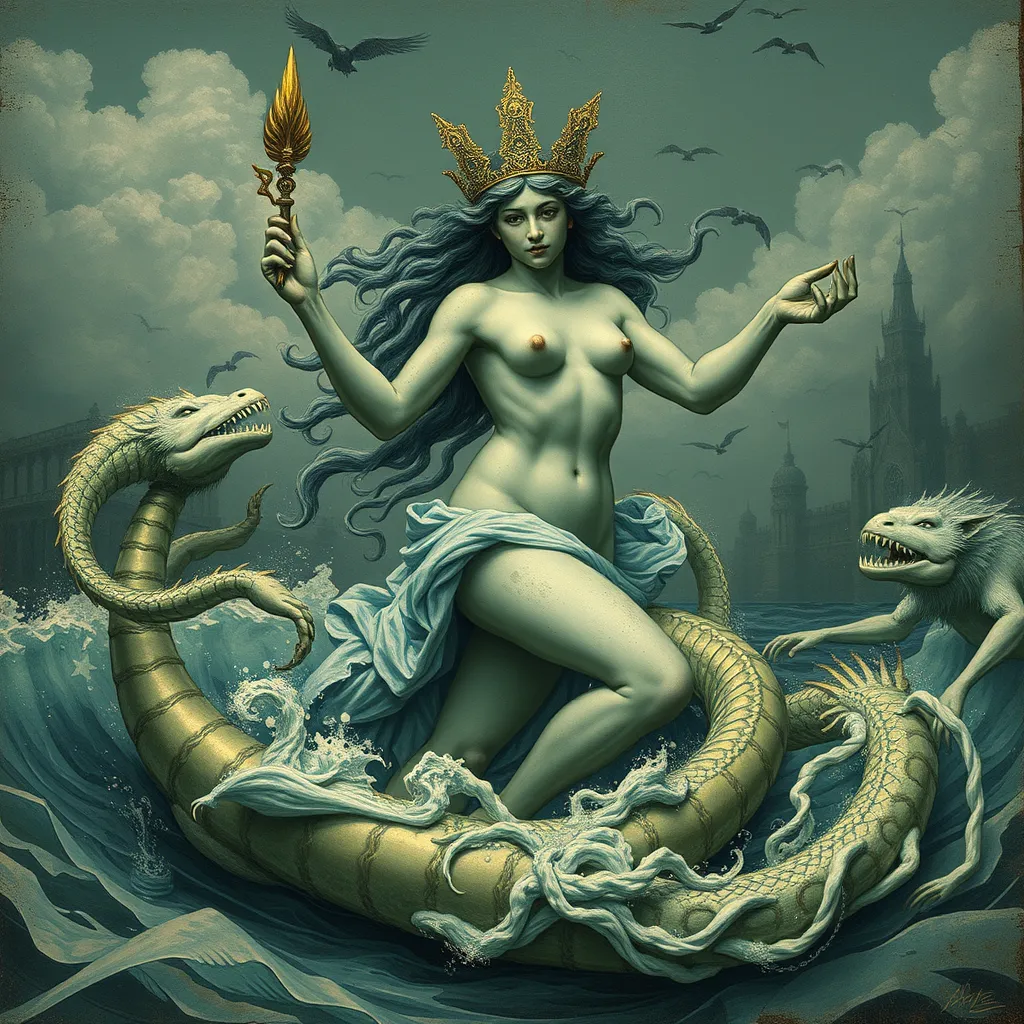The Hydra’s Influence on Religious Beliefs: Examining the Serpent as a Symbol of Evil
I. Introduction
The concept of the Hydra, a multi-headed serpent from Greek mythology, has long fascinated scholars, artists, and theologians alike. Known for its regenerative capabilities, the Hydra has become an enduring symbol of chaos, evil, and the perennial struggle between good and evil. This article aims to explore the Hydra’s role in shaping religious perceptions of evil, examining the broader implications of serpent symbolism across various cultures and religions.
II. The Hydra in Mythology
A. Origins of the Hydra in Greek Mythology
The Hydra is a legendary creature that first appeared in Greek mythology, associated with the hero Heracles (Hercules). According to the myths, the Hydra resided in the swamps of Lerna and was said to have multiple heads, with the ability to regenerate two heads for each one that was severed. This aspect of the Hydra made it a formidable foe for Heracles, who was tasked with slaying it as one of his Twelve Labors.
B. Key Characteristics and Stories Associated with the Hydra
The Hydra is often depicted with a serpentine body and numerous heads, symbolizing its chaotic nature. One of the most famous stories involving the Hydra is Heracles’ battle, where he ultimately sought the help of his nephew Iolaus, who cauterized the necks after Heracles cut off the heads, preventing them from regenerating. This tale not only highlights the creature’s resilience but also the themes of teamwork and ingenuity in overcoming evil.
C. The Hydra’s Representation of Chaos and Regeneration
In many ways, the Hydra embodies chaos and the cyclical nature of evil. Its ability to regenerate signifies that evil cannot be easily eradicated; it requires vigilance and effort to combat. This concept of persistent evil resonates throughout various narratives, making the Hydra an essential symbol in understanding the complexities of moral struggles in mythology.
III. The Serpent in Religious Texts
A. Serpent Symbolism Across Various Religions
The serpent is a ubiquitous symbol found in numerous religious texts and traditions worldwide. Its meanings vary significantly, often representing both good and evil. In Christianity, for example, the serpent in the Garden of Eden is a symbol of temptation and sin, while in other cultures, such as Hinduism, serpents (nagas) can symbolize protection and fertility.
B. The Role of Serpents in Creation Myths and Dualistic Narratives
Serpents frequently appear in creation myths and dualistic narratives, embodying the conflict between order and chaos. In many traditions, they are seen as guardians of knowledge or thresholds between worlds. This duality creates a complex framework for understanding the serpent as both a harbinger of evil and a source of wisdom.
C. Comparison of the Hydra’s Symbolism with Other Serpent Figures
The Hydra’s symbolism can be compared to other notable serpent figures, such as the biblical serpent and the Aztec god Quetzalcoatl. While the Hydra represents chaotic evil, the biblical serpent often embodies temptation, and Quetzalcoatl symbolizes life and rebirth. This comparison highlights the multifaceted nature of serpent symbolism across cultures.
IV. The Hydra as a Metaphor for Evil
A. The Hydra’s Regenerative Abilities and the Concept of Persistent Evil
The regenerative abilities of the Hydra serve as a powerful metaphor for the nature of evil in the world. Just as the creature regrows heads, evil can manifest in various forms, regardless of how many times it is confronted. This idea challenges the notion that evil can be entirely vanquished, suggesting instead that it requires constant vigilance.
B. Analysis of the Hydra’s Depiction in Art and Literature as a Symbol of Malevolence
Throughout history, the Hydra has been depicted in art and literature as a symbol of malevolence. From ancient pottery to modern films, the creature often represents not only physical danger but also moral and existential threats. This portrayal serves to remind audiences of the complexities of evil and the ongoing struggle against it.
C. The Psychological Implications of the Hydra in the Context of Evil
Psychologically, the Hydra can represent the fears and anxieties that individuals and societies hold regarding evil. Its multiple heads can symbolize the various forms that evil can take, reflecting the chaotic nature of human existence. The Hydra’s image often evokes a sense of dread and the impossibility of fully eradicating malevolence.
V. Cultural Interpretations of the Serpent
A. The Serpent in Judeo-Christian Traditions: From Genesis to Revelation
In Judeo-Christian traditions, the serpent is predominantly viewed as a symbol of temptation and sin. In the Book of Genesis, the serpent tempts Eve, leading to humanity’s fall from grace. Conversely, in the Book of Revelation, serpents are often associated with darkness and evil, representing Satan’s influence in the world.
B. Eastern Perspectives on Serpents, Including Hindu and Buddhist Interpretations
In Eastern religions, serpents often hold different meanings. In Hinduism, for example, the nagas are considered protectors of springs and rivers, signifying fertility and renewal. In Buddhism, the serpent is associated with the guardian of the Buddha and is seen as a symbol of protection and strength, contrasting sharply with Western interpretations.
C. The Hydra’s Influence on Modern Cultural Representations of Evil
The Hydra continues to influence modern culture, appearing in literature, films, and video games as a representation of evil. Its multi-headed nature serves as a potent image for the complexities of modern threats, reflecting societal concerns about terrorism, systemic oppression, and the multifaceted nature of evil.
VI. The Evolution of the Serpent’s Symbolism
A. Historical Shifts in the Perception of Serpents and Hydras
Over time, the perception of serpents has evolved significantly. In ancient cultures, they were often revered as symbols of wisdom and protection, while in modern contexts, they are frequently demonized as embodiments of evil. This shift illustrates the fluid nature of cultural symbols and their meanings.
B. The Impact of Folklore and Fairy Tales on the Serpent’s Image
Folklore and fairy tales have played a critical role in shaping the image of serpents throughout history. Stories like that of the dragon-slaying hero often draw on the serpent’s symbolism of chaos and evil, reinforcing the notion that such creatures must be vanquished for good to prevail.
C. Contemporary Reinterpretations of the Hydra in Popular Culture
In contemporary popular culture, the Hydra is often reinterpreted in various media, from movies to video games. These portrayals usually emphasize its regenerative capabilities, often leading to themes of resilience and the ongoing battle against evil. This reflects a modern understanding of the complexities of morality and the challenges posed by persistent threats.
VII. The Psychological and Sociological Impacts
A. The Role of the Hydra in Shaping Societal Fears and Taboos
The Hydra serves as a significant symbol in shaping societal fears and taboos. Its representation of persistent evil resonates with cultural anxieties surrounding crime, war, and moral decay. This creature embodies the fears of individuals and societies, reflecting deeper concerns about the nature of evil in the human experience.
B. The Impact of Serpent Symbolism on Collective Human Consciousness
Serpent symbolism has a profound impact on collective human consciousness. It influences how societies perceive danger, morality, and the duality of good and evil. The Hydra, as a symbol, embodies the complexities of these themes, shaping narratives that explore the human condition.
C. The Influence of Religious Beliefs on Moral Frameworks and Behavior
Religious beliefs play a crucial role in shaping moral frameworks and behaviors. The portrayal of the Hydra as a symbol of evil reinforces the idea that individuals must confront and overcome malevolent forces in their lives. This struggle is often mirrored in religious teachings, which emphasize the importance of moral integrity and the fight against evil.
VIII. Conclusion
In conclusion, the Hydra’s enduring influence on religious beliefs and cultural narratives underscores its significance as a symbol of evil. Through its representation of chaos, regeneration, and duality, the Hydra challenges our understanding of morality and the nature of evil. While often depicted as a malevolent force, the serpent also embodies wisdom and the potential for renewal. As we reflect on the relevance of the Hydra in modern religious discourse, it becomes clear that its symbolism continues to resonate, reminding us of the ongoing struggle against the multifaceted nature of evil in our lives



